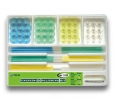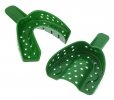PURPOSE:The purpose of this study was to assess the effect of systemically administered oxytocin (OT) on the implant-bone interface by using histomorphometric analysis and the removal torque test. MATERIALS AND METHODS:A total of 10 adult, New Zealand white, female rabbits were used in this experiment. We placed 2 implants (CSM;CSM Implant, Daegu, South Korea) in each distal femoral metaphysis on both the right and left sides; the implants on both sides were placed 10 mm apart. In each rabbit, 1 implant was prepared for histomorphometric analysis and the other 3 were prepared for the removal torque test (RT). The animals received intramuscular injections of either saline (control group; 0.15 M NaCl) or OT (experimental group; 200 µg/rabbit). The injections were initiated on Day 3 following the implant surgery and were continued for 4 subsequent weeks; the injections were administered twice per day (at a 12-h interval), for 2 days per week. RESULTS:While no statistically significant difference was observed between the two groups (P=.787), the control group had stronger removal torque values. The serum OT concentration (ELISA value) was higher in the OT-treated group, although no statistically significant difference was found. Further, the histomorphometric parameter (bone-toimplant contact [BIC], inter-thread bone, and peri-implant bone) values were higher in the experimental group, but the differences were not significant. CONCLUSION:We postulate that OT supplementation via intramuscular injection weakly contributes to the bone response at the implant-bone interface in rabbits. Therefore, higher concentrations or more frequent administration of OT may be required for a greater bone response to theimplant. Further studies analyzing these aspects are needed.
Source:PMID: 25551011 PubMed PMCID: PMC4279050 |
-
منوی اصلیبستن
-
Dental
-
-
-
Gloves
-
-
-
Gloves
-
-
-
Gloves
-
-
-
Gloves
-
-
-
Dental Finishing & Polishing
-
-
-
Gloves
-
-
-
Gloves
-
-
-
Gloves
-
-
-
Gloves
-
-
-
Gloves
-
-
-
Gloves
-
-
-
-
Gloves
-
-
-
Gloves
-
-
-
Gloves
-
-
-
-
-
Gloves
-
-
-
Gloves
-
-
-
Gloves
-
-
-
Gloves
-
-
-
Gloves
-
-
-
Gloves
-
-
-
Gloves
-
-
-
- Mag
-
Laboratory
-
-
Laboratory Equioment
-
-
-
-
Lab
-
-
-
Medical
-
-
-
-
تجهیزات تشخیص
-
تجهیزات عکس برداری
-
-
-
- Help
-
Corporate
-
- Login/ Register
-
منوی اصلیبستن
-
Dental
-
-
-
Gloves
-
-
-
Gloves
-
-
-
Gloves
-
-
-
Gloves
-
-
-
Dental Finishing & Polishing
-
-
-
Gloves
-
-
-
Gloves
-
-
-
Gloves
-
-
-
Gloves
-
-
-
Gloves
-
-
-
Gloves
-
-
-
-
Gloves
-
-
-
Gloves
-
-
-
Gloves
-
-
-
-
-
Gloves
-
-
-
Gloves
-
-
-
Gloves
-
-
-
Gloves
-
-
-
Gloves
-
-
-
Gloves
-
-
-
Gloves
-
-
-
- Mag
-
Laboratory
-
-
Laboratory Equioment
-
-
-
-
Lab
-
-
-
Medical
-
-
-
-
تجهیزات تشخیص
-
تجهیزات عکس برداری
-
-
-
- Help
-
Corporate
-
- Login/ Register
- Home
- Blog
- Dandal News
- Scientific Blog
- Article
- The influence of systemically administered oxytocin on the implant-bone
Iran Dentistry Magazine
Blog categories
The influence of systemically administered oxytocin on the implant-bone
Related products
Jota - Diamond Burs - Round - FG

Tor VM - Finishing & Polishing Kit (Stem Disc+Strip)

Tor VM - Wooden Wedges of 6 Types

Taksan - Dr.Roufi Tray


